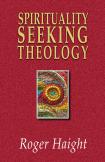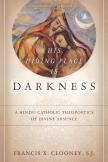Inside Sacred Texts
These two books have at first sight little in common, other than the fact that they are written by two prominent Jesuit theologians. In Spirituality Seeking Theology, Roger Haight, S.J., attempts to reach behind or beneath established Christian doctrines of creation, incarnation, trinity and eschatology to bring out the original and enduring spiritual meaning and intention of such doctrinal formulations. The book is not, as one might think, an attempt to discover a generic spirituality which would be distinct from or opposed to “religion.”
On the contrary, Haight’s focus is on a distinctly Christian spirituality, or on a spirituality shaped by faith in Jesus Christ; and his understanding of religion is strong, involving social, institutional, doctrinal ritual and spiritual dimensions. Moreover, his understanding of spirituality is not limited to the experiential dimension, but includes a way of life and relating to the world and others. He in fact defines spirituality as “the playing out of one’s faith in action” and Christian spirituality as simply “following Jesus.” Haight’s account of Christian spirituality is profoundly orthodox or faithful to the teachings of the Catholic Church. He acknowledges the different interpretations of the meaning of Jesus’ divinity in the early church, but his intention is to point to the deeper spiritual meaning and logic of the final creedal statements. By focusing on spirituality, he offers a fresh perspective on traditional Christian doctrines. And more than many other theologians, he also emphasizes the essential missionary orientation of the church or the “priority of mission to the identity of the Church.”
This quintessentially Christian approach to spirituality raises a question regarding his bifurcation of spirituality and doctrine, or spirituality and the church. Haight regards spirituality as “prior to the church” and “prior to and the basis of the theology and the doctrines of the church.” While he defines spirituality as “the sum total of a person’s actions as he or she moves along in life,” he approaches theology as “the academic discipline of understanding reality critically through the symbols of Christian faith.”
However, all Christian faith and spirituality contains a basic theology, or an elementary understanding and conceptualization of faith. Moreover, throughout the book, Haight seeks recourse and inspiration from important theologians (Rahner, Schillebeeckx, Sobrino, Moltmann, etc.) to help him interpret Christian doctrines. This points to the inseparability of Christian spirituality and doctrine, or to their essential interconnection in the Christian experience of faith. This critical comment in no way takes away from the value of this book. At a time when indeed “Christian doctrine has lost traction with the faithful” the church can use all of the spiritual inspiration and creative theological reflection available to break open and bring to new light the enduring meaning of traditional doctrines.
Francis Clooney, S.J.’s His Hiding Place is Darkness takes us into an entirely different world of experience and expression of divine absence in a biblical and in a Hindu sacred text. Comparing the Song of Songs through some of its Christian commentors (Bernard of Clairvaux, Gilbert of Hoyland and John of Ford) with the Holy Word of Mouth through some of its medieval Hindu interpreters (Nanjiyar, Nampillai and Periyavacchan), he brings out some of the analogous poetic themes or tropes present in the two texts. This points to the extraordinary scholarly erudition required to engage in this type of comparative theological exercise. However, in addition to the Hindu and Christian texts, Clooney also draws from the poetry of Gerald Manley Hopkins and Jorie Graham in order to further bring out the complexity of speaking and writing about an experience that is ever fleeting and beyond words. The book thus contains various layers: a juxtaposition of two sacred texts dealing with the feelings of ecstasy and pain at the experiences of union with and separation from the beloved divine reality, a discussion on the place of poetry in theological discourse and finally, reflections on the implications of all this for theology of religions and for comparative theology.
As with Clooney’s other works, the goal of reading sacred texts from two different religions side by side is that of “intensifying” the meaning and depth of a particular text and tradition. In this case, Clooney suggests that the reading may bring a Christian to “intensify her desire for Jesus” even while “images and scenes from Hindu poetry flood our imaginations.” The comparison of the two texts indeed broaden one’s religious imagination while also raising certain challenging theological questions, such as “does God have more than one love?” With regard to the second layer, Clooney turns to Hans Urs von Balthasar to point to the important role of poetry and drama in theological discourse. The dynamic relationship between the three, Clooney states, “does not undercut the possibility of theological assertion or a community’s desire for doctrinal certainty, but it does cast a harsher light on theologies that have become stagnant.” His attempt at a comparative theo-poetics thus opens the door to new images and shades of experience that cannot but enrich Christian theological reflection.
While Clooney states modestly that “my book is no work of poetry, but it devotes itself to the reading of poetry,” it is beautifully written in a style flowing with the texts he reads. With regard to the third layer of the book, while Clooney does not develop a systematic theology of religions, he interjects passing comments or reflections on the implications of his work for the faith of the comparative theologian. For example, in a passage that reads like a personal testimony, Clooney writes that “If we manage some empathy with each and both [of the women protagonists in the poems], we will not be able to finish off any neat comparison and then move on.
In this poetic and dramatic realm, we find—to our pleasure or dismay—that our beloved is not only in hiding but that he is also more than we had imagined, he goes to places we do not visit, and may even be known by names we have not heard before. He has other lovers too. This admission need not make impossible a commitment to one true love. . . this is about more love, not less.” This passage contains a rich theology of religions which Clooney—as in his other works—prefers to evoke, rather than to elaborate.
While the two books reviewed in this essay are thus fundamentally different in their respective subject matter and orientation, they both attach great importance to the imagination, a richly Jesuit theme. Haight repeatedly returns to this theme as a necessary condition for understanding Jesus’ life and message and for reimagining it in our times. Clooney refers to the essential role of the imagination in entering into the depth of poetic meaning of not only one’s own, but also the other’s sacred text. In both books, the imagination also serves the function of bringing about a certain freedom and detachment from fixed doctrinal formulations and of bringing new life and meaning into Christian faith. In that respect, His Hiding Place is Darkness and Spirituality Seeking Theology are texts that take seriously the challenges and the possibilities facing Christian theology today and propose new and creative avenues for advancing Christian spiritual life.
This article also appeared in print, under the headline “Inside Sacred Texts,” in the November 17, 2014, issue.









